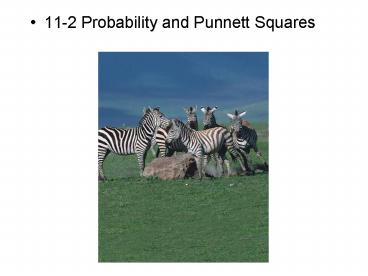11-2 - PowerPoint PPT Presentation
1 / 21
Title:
11-2
Description:
11-2 Probability and Punnett Squares 11-2 Probability and Punnett Squares How do geneticists use the principles of probability? Genetics and Probability Genetics and ... – PowerPoint PPT presentation
Number of Views:88
Avg rating:3.0/5.0
Title: 11-2
1
11-2 Probability and Punnett Squares
- 11-2 Probability and Punnett Squares
2
Genetics and Probability
- How do geneticists use the principles of
probability?
3
Genetics and Probability
- Genetics and Probability
- The likelihood that a particular event will occur
is called probability. - The principles of probability can be used to
predict the outcomes of genetic crosses.
4
Punnett Squares
- How do geneticists use Punnett squares?
5
Punnett Squares
- Punnett Squares
- The gene combinations that might result from a
genetic cross can be determined by drawing a
diagram known as a Punnett square. - Punnett squares can be used to predict and
compare the genetic variations that will result
from a cross. - From Punnett squares, you can predict the
probable genotype and phenotype of an organism.
6
Punnett Squares
- A capital letter represents the dominant allele
for tall. - A lowercase letter represents the recessive
allele for short. - In this example,
- T tall
- t short
7
Punnett Squares
- Gametes produced by each F1 parent are shown
along the top and left side.
8
Punnett Squares
- Possible gene combinations for the F2 offspring
appear in the four boxes.
9
Punnett Squares
- Organisms that have two identical alleles for a
particular trait are said to be homozygous. - Organisms that have two different alleles for the
same trait are heterozygous. - Homozygous organisms are true-breeding for a
particular trait. - Heterozygous organisms are hybrid for a
particular trait.
10
Punnett Squares
- All of the tall plants have the same phenotype,
or physical characteristics. - The tall plants do not have the same genotype, or
genetic makeup. - One third of the tall plants are TT, while two
thirds of the tall plants are Tt.
11
Punnett Squares
- The plants have different genotypes (TT and Tt),
but they have the same phenotype (tall).
Tt Heterozygous
TT Homozygous
12
Probability and Segregation
- Probability and Segregation
- One fourth (1/4) of the F2 plants have two
alleles for tallness (TT). - 2/4 or 1/2 have one allele for tall (T), and one
for short (t). - One fourth (1/4) of the F2 have two alleles for
short (tt).
13
Probability and Segregation
- Because the allele for tallness (T) is dominant
over the allele for shortness (t), 3/4 of the F2
plants should be tall. - The ratio of tall plants (TT or Tt) to short (tt)
plants is 31. - The predicted ratio showed up in Mendels
experiments indicating that segregation did occur.
14
Probabilities Predict Averages
- Probabilities Predict Averages
- Probabilities predict the average outcome of a
large number of events. - Probability cannot predict the precise outcome of
an individual event. - In genetics, the larger the number of offspring,
the closer the resulting numbers will get to
expected values.
15
11-2
16
11-2
- Probability can be used to predict
- average outcome of many events.
- precise outcome of any event.
- how many offspring a cross will produce.
- which organisms will mate with each other.
17
11-2
- Compared to 4 flips of a coin, 400 flips of the
coin is - more likely to produce about 50 heads and 50
tails. - less likely to produce about 50 heads and 50
tails. - guaranteed to produce exactly 50 heads and 50
tails. - equally likely to produce about 50 heads and 50
tails.
18
11-2
- Organisms that have two different alleles for a
particular trait are said to be - hybrid.
- heterozygous.
- homozygous.
- recessive.
19
11-2
- Two F1 plants that are homozygous for shortness
are crossed. What percentage of the offspring
will be tall? - 100
- 50
- 0
- 25
20
11-2
- The Punnett square allows you to predict
- only the phenotypes of the offspring from a
cross. - only the genotypes of the offspring from a cross.
- both the genotypes and the phenotypes from a
cross. - neither the genotypes nor the phenotypes from a
cross.
21
END OF SECTION































